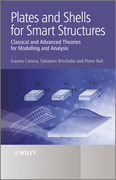
Plates and shells for smart structures: classical and advanced theories for modelling and analysis
Carrera, Erasmo
Giunta, Gaetano
Brischetto, Salvatore
Plates and Shells for Smart Structures firstly gives an overview of classicalplate and shell theories for piezoelectric elasticity, demonstrating their limitations in static and dynamic analysis with a number of example problems. The authors then go on to explain how these limitations can be overcome with theuse of the more advanced models that have been developed in recent years; introducing theories able to consider electromechanical couplings as well as those that provide appropriate interface continuity conditions for both electricaland mechanical variables. They provide both analytical and finite element solutions, thus enabling the reader to compare the strong and weak solutions to problems. Plates and Shells for Smart Structures is accompanied by dedicated software MUL2 that is used to obtain the numerical solutions in the book, allowing the reader to reproduce the examples given in the book as well as to solve other problems of their own. ÍNDICE: Preface 1 Introduction 1.1 Direct and Inverse Piezoelectric Effects 1.2 Some Known Applications of Smart Structures References 2 Basics of Piezoelectricity and the Related Principles 2.1 Piezoelectric Materials 2.2 Constitutive Equations for Piezoelectric Problems 2.3 Geometrical Relations for Piezoelectric Problems 2.4 Principle of Virtual Displacements, PVD 2.4.1 PVD for the Pure Mechanical Case 2.5 Reissner Mixed Variational Theorem, RMVT 2.5.1 RMVT(u, , 3/4n) 2.5.2 RMVT (u, , Dn) 2.5.3 RMVT (u, , 3/4n, Dn) References 3 Classical Plate/Shell Theories 3.1 Plate/Shell Theories 3.1.1 Three-dimensional Problems 3.1.2 Two-dimensional Approaches 3.2 Complicating Effects of Layered Structures 3.3 Classical Theories 3.3.1 Classical Lamination Theory, CLT 3.3.2 First-order Shear Deformation Theory, FSDT 3.3.3 Vlasov-Reddy Theory, VRT 3.4 Classical Plate Theories Extended to Smart Structures 3.4.1 CLT Plate Theory Extended to Smart Structures 3.4.2 FSDT Plate Theory Extended to Smart Structures 3.5 Classical Shell Theories Extended to Smart Structures 3.5.1 CLT and FSDTShell Theories Extended to Smart Structures References 4 Finite Element Applications 4.1 Preliminaries 4.2 Finite Element Discretization 4.3 FSDT Finite Element Plate Theory Extended to Smart Structures References 5 Numerical Evaluation of Classical Theories and Their Limitations 5.1 Static Analysis of Piezoelectric Plates 5.2 Static Analysis of Piezoelectric Shells 5.3 Vibration Analysis of Piezoelectric Plates 5.4 Vibration Analysis of Piezoelectric Shells References 6 Refined and Advanced Theories for Plates 6.1 Unified Formulation: Refined Models 6.1.1 Equivalent Single Layer Theories, ESL 6.1.2 Murakami ZigZag Function, MZZF 6.1.3 Layer Wise Theories, LW 6.1.4 Refined Models for the Electro-Mechanical Case 6.2 Unified Formulation: Advanced Mixed Models 6.2.1 Transverse Shear/Normal Stresses Modelling 6.2.2 Advanced Mixed Models for the Electro-Mechanical Case 6.3 PVD (u, ) for the Electro-Mechanical Plate Case 6.4 RMVT (u, , 3/4n) for the Electro-Mechanical Plate Case 6.5 RMVT (u, , Dn) for the Electro-Mechanical Plate Case 6.6 RMVT (u, , 3/4n, Dn) for the Electro-Mechanical Plate Case 6.7 Assembling Procedure for Fundamental Nuclei 6.8 Acronyms for Refined and Advanced Models 6.9 Pure Mechanical Problems as Particular Cases, PVD (u) and RMVT (u, 3/4n) 6.10 Classical Plate Theories as Particular Cases of Unified Formulation References 7 Refined and Advanced Theories for Shells 7.1 Unified Formulation: Refined Models 7.1.1 Equivalent Single Layer Theories, ESL 7.1.2 Murakami ZigZag Function, MZZF 7.1.3 Layer Wise Theories, LW 7.1.4 Refined Models for the Electro-Mechanical Case 7.2 Unified Formulation: Advanced Mixed Models 7.2.1 Transverse Shear/Normal Stress Modelling 7.2.2 Advanced Mixed Models for the Electro-Mechanical Case 7.3 PVD (u, ) for the Electro-Mechanical Shell Case 7.4 RMVT (u, , 3/4n) for the Electro-Mechanical Shell Case 7.5 RMVT (u, , Dn) for the Electro-Mechanical Shell Ca
- ISBN: 978-0-470-97120-8
- Editorial: John Wiley & Sons
- Encuadernacion: Cartoné
- Páginas: 312
- Fecha Publicación: 30/09/2011
- Nº Volúmenes: 1
- Idioma: Inglés
